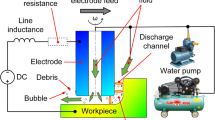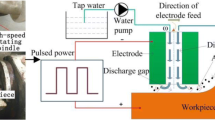Abstract
Short electrical arc machining (SEAM) is a novel electro-machining technology, and it is suitable for machining all kinds of conductive materials with high machining efficiency. To improve the processing efficiency, a hybrid power system comprised of SEAM power source and a pulsed & direct current power source was implemented in SEAM. The influences of the combined pulse voltage produced by the hybrid power system on SEAM performance were studied, and Taguchi method was designed and carried out. The results indicated that material removal rate (MRR) increases and tool wear rate (TWR) decreases with the increase of combined pulse voltage, while the combined pulse voltage has a mild effect on surface roughness (Rz). Peak current is responsible for MRR in the machining process, while peak current and spindle speed are the dominant effect factors on TWR, and the effects of flushing pressure and peak current are responsible for Rz. Additionally, the higher the pulse voltage, the higher the MRR, the lower the TWR, and the relative electrode wear ratio (REWR). The MRR, TWR, REWR, and Rz decrease with the increase of flushing pressure.
Similar content being viewed by others
References
Lin M-Y, Tsao C-C, Hsu C-Y, Chiou A-H, Huang P-C, Lin Y-C (2013) Optimization of micro milling electrical discharge machining of Inconel 718 by Grey-Taguchi method. Trans Nonferrous Metals Soc China 23(3):661–666
Trimmer AL, Hayashi S, Lamphere M (2010) Advancement in high speed electro-erosion processes for machining tough metals. Proceedings of the 16th International Sympo-sium on Electromachining Shanghai
Kao JY, Tsao CC, Wang SS, Hsu CY (2009) Optimization of the EDM parameters on machining Ti–6Al–4V with multiple quality characteristics. Int J Adv Manuf Technol 47(1–4):395–402. doi:10.1007/s00170-009-2208-3
Rasheed MS, Al-Ahmari A, El-Tamimi A, Abidi MH (2012) Analysis of influence of micro-EDM parameters on MRR, TWR and Ra in machining Ni-Ti shape memory alloy. International Journal of Recent Technology and Engineering 1(4):32–37
Jabbaripour B, Sadeghi MH, Faridvand S, Shabgard MR (2012) Investigating the effects of EDM parameters on surface integrity, MRR and TWR in machining of Ti–6Al–4V. Mach Sci Technol 16(3):419–444. doi:10.1080/10910344.2012.698971
Ayesta I, Izquierdo B, Sánchez JA, Ramos JM, Plaza S, Pombo I, Ortega N, Bravo H, Fradejas R, Zamakona I (2013) Influence of EDM parameters on slot machining in C1023 aeronautical alloy. Procedia CIRP 6:129–134. doi:10.1016/j.procir.2013.03.059
Dave HK, Mathai VJ, Mayanak MK, Raval HK, Desai KP (2015) Study on effect of process parameters on overcut and tool wear rate during micro-electro-discharge slotting process. Int J Adv Manuf Technol:1–12
Wang F, Liu Y, Zhang Y, Tang Z, Ji R, Zheng C (2014) Compound machining of titanium alloy by super high speed EDM milling and arc machining. J Mater Process Technol 214(3):531–538. doi:10.1016/j.jmatprotec.2013.10.015
Wang F, Liu Y, Tang Z, Ji R, Zhang Y, Shen Y (2013) Ultra-high-speed combined machining of electrical discharge machining and arc machining. Proc Inst Mech Eng B J Eng Manuf 228(5):663–672. doi:10.1177/0954405413506194
Zhao W, Gu L, Xu H, Li L, Xiang X (2013) A novel high efficiency electrical erosion process–blasting erosion arc machining. Procedia CIRP 6:621–625. doi:10.1016/j.procir.2013.03.057
Zhou BS, Zhou BH (2007) Technology of short electrical arc milling. Proceedings of the Chinese mechanical engineering society annual meeting in 2007
Jiang L, Chuhua L, Bisheng Z (2011) The research of the high efficiency based on the short electricity arc cutting. Electromachining & Mould 2:015
Zhang M, Zhang Q, Wang H, Liu G, Guo T (2015) Research on a single pulse discharge to discriminate EDM and EAM based on the plasma tunnel and crater geometry. J Mater Process Technol 219:248–256
Zhang JZ, Zhou JP, Xu Y, Zhang XF (2013) The pilot study of short arc processing discharge process. Mod Manuf Eng (11):93–96
Liu HS (2014) Experimental research of SEAM discharge parameters affecting on the surface quality. Xinjiang University
Wang BB, Zhou JP, Xu Y, Jiang H (2015) The experiment research of processing performance of nickel-base superalloy and electrode loss rule by short electric arc milling. Manuf Technol Mach Tool (10):139–143
Zhou JP, Liang CH, Teng WJ, Xu Y, Zhou BS (2008) Study on rules in material removal rate and surface quality of short electric arc machining process. In: Advanced Materials Research. Trans Tech Publ, pp 1313–1318
Zhou BS, Zhou XM (2013) Application of short arc machining technology in cement grinding roller, roller mill roller efficient processing. Proceedings of the 15th International Academic Conference on Non-traditional Machining
Zhang M, Zhang Q, Dou L, Zhu G, Dong C (2016) An independent discharge status detection method and its application in EAM milling. Int J Adv Manuf Technol:1–10
Patowari PK, Saha P, Mishra PK (2011) Taguchi analysis of surface modification technique using W-Cu powder metallurgy sintered tools in EDM and characterization of the deposited layer. Int J Adv Manuf Technol 54(5–8):593–604
Bhattacharya A, Batish A, Singh G, Singla V (2012) Optimal parameter settings for rough and finish machining of die steels in powder-mixed EDM. Int J Adv Manuf Technol 61(5–8):537–548
Chen J, Gu L, Xu H, Zhao W (2015) Study on blasting erosion arc machining of Ti–6Al–4V alloy. Int J Adv Manuf Technol:1–11
Author information
Authors and Affiliations
Corresponding author
Rights and permissions
About this article
Cite this article
Zhu, G., Zhang, Q., Wang, H. et al. Machining behaviors of short electrical arc milling with high frequency and high voltage pulses. Int J Adv Manuf Technol 90, 1067–1074 (2017). https://doi.org/10.1007/s00170-016-9399-1
Received:
Accepted:
Published:
Issue Date:
DOI: https://doi.org/10.1007/s00170-016-9399-1




